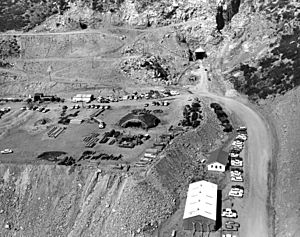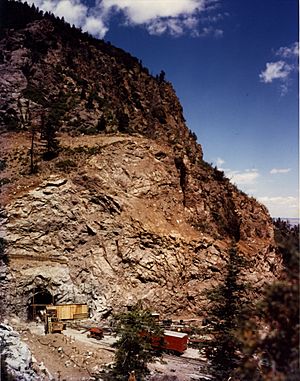Construction of the Cheyenne Mountain Complex facts for kids
The Cheyenne Mountain Complex is a super strong military base built deep inside Cheyenne Mountain in Colorado Springs, Colorado. Its construction started on May 18, 1961, and it was fully ready to use by February 6, 1967. This special place was designed as a safe, underground bunker during the Cold War. It was meant to protect against attacks from long-range bombers and missiles. The North American Aerospace Defense Command (NORAD) used to have its main headquarters here. Today, it's known as the Cheyenne Mountain Space Force Station and still hosts important military groups, including parts of NORAD.
Contents
Planning a Super Strong Base
From the start of the Cold War, leaders in America wanted to create a strong air defense. They believed this was needed to protect against possible attacks from Soviet bombers. The Air Defense Command moved to Ent Air Force Base in Colorado Springs in 1951.
In 1957, the North American Air Defense Command (NORAD) was officially formed at Ent Air Force Base. By the late 1950s, a plan was made to build a command center deep underground. This was a key part of the Cold War defense plan. The goal was to protect against Soviet bombers, missiles, and nuclear attacks.
Other strong bunkers were also built around this time. These were part of a national plan to keep the U.S. government working even during a nuclear attack. Some examples include the Raven Rock Mountain Complex (built 1953) and Mount Weather Emergency Operations Center (built 1959).
Digging into the Mountain
The main operations center needed to be moved from an exposed building. It had to be safe inside the "granite shielded security" of Cheyenne Mountain. Even telephone companies like AT&T had started putting their equipment in underground bunkers. This showed how important it was to protect vital systems.
The United States Army Corps of Engineers oversaw the digging of the mountain. This was for NORAD's Combat Operations Center. Digging began on May 18, 1961. A company called Utah Construction & Mining Company did the work. Experts from the Colorado School of Mines helped with special blasting methods. These methods made sure the tunnels were smooth and strong.
The official groundbreaking ceremony happened on June 16, 1961. Generals from the Air Defense Command and NORAD set off dynamite charges together. In December 1961, about half of the digging was done. There was a short worker strike, but it was quickly resolved.
By August 1962, the digging was almost finished. However, a crack in the rock ceiling needed a huge concrete dome for support. This added to the cost. President John F. Kennedy visited NORAD in June 1963 to check on the progress. The digging was fully completed on May 1, 1964.
In September 1964, the Secretary of Defense approved the plans for the underground center. The goal was to have the military staff ready by January 1, 1966.
Building Inside the Mountain
The main design for the buildings was created by Parsons Brinckerhoff Company. The estimated cost for building the operations center and adding equipment was $66 million. The complex was built in the mid-1960s.
In February 1963, a company won a contract to build 11 buildings. These buildings were special because they sat on giant springs. This design would help them survive a powerful blast. Eight of these buildings had three stories, and three had two stories. They covered a total area of about 170,000 square feet.
Other companies installed blast-control equipment and utilities. This included six large diesel generators. These generators could produce 956 kilowatts of power each. Workers also dug out reservoirs inside the mountain for water and fuel oil.
By 1965, the NORAD Combat Operations Center was connected to national phone systems. This was done through a special "blast-resistant" communication system. It was built hundreds of feet under solid rock. This system had several remote locations, far from the mountain. This allowed for different ways to send data, messages, and voice calls. Information from early warning radar sites around the world came through this system.
Setting Up the Systems
Burroughs Corporation created a special computer system for NORAD. This system helped to quickly evaluate information from aerospace surveillance. It could process data in a millionth of a second. The Space Defense Center, which tracked objects in space, moved into the new Cheyenne Mountain center. It became active on September 3, 1965.
The facility's Combat Operations Center was handed over to NORAD on January 1, 1966. On April 20, 1966, NORAD declared its command and control system fully ready. The 1st Aerospace Control Squadron also moved into Cheyenne Mountain in April 1966.
The NORAD Attack Warning System started working on May 20, 1966. The Combat Operations Command was fully operational by July 1, 1966. A large computer system called Delta I also became operational in October 1966. It had 53 different programs. It helped detect and warn about threats from space. By January 1967, the National Civil Defense Warning Center was also inside the bunker.
The Space Defense Center and the Combat Operations Center were fully ready on February 6, 1967. The total cost for the complex was about $142.4 million. This would be over $1 billion in today's money.
Images for kids
See also
 In Spanish: Construcción del Complejo de Cheyenne Mountain para niños
In Spanish: Construcción del Complejo de Cheyenne Mountain para niños





